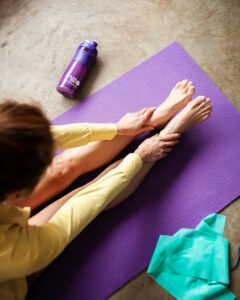
Engaging in regular physical activity is essential for maintaining good health, but the choices can be overwhelming. Among the myriad exercise forms available, Pilates, Yoga, and CrossFit are prominent options, each with its own unique approach and benefits. In this discussion, we’ll compare Pilates to these other exercise forms to help you better understand their differences and determine which might be the most suitable for your fitness goals and preferences.
What is better Pilates or CrossFit?
Pilates and CrossFit are two vastly different exercise modalities, each with its own strengths. The choice between them depends on your fitness goals, preferences, and physical condition.
Pilates:
· Focus: Pilates emphasizes core strength, flexibility, balance, and body awareness.
· Intensity: It is generally low-impact, making it suitable for people of various fitness levels, including beginners and those with injuries.
· Equipment: Pilates often incorporates specialized equipment like reformers and Cadillac machines, but it can also be done with just a mat.
· Benefits: Pilates is excellent for improving posture, developing a strong core, and enhancing flexibility. It is particularly effective for individuals seeking a leaner, toned physique and improved mind-body connection.
CrossFit:
· Focus: CrossFit is known for its high-intensity, functional fitness workouts that incorporate weightlifting, cardio, and gymnastics elements.
· Intensity: It is a high-intensity exercise program designed to push your limits and promote strength and conditioning.
· Equipment: CrossFit workouts often involve barbells, kettlebells, pull-up bars, and other equipment.
· Benefits: CrossFit is ideal for those who seek to build strength, power, and cardiovascular endurance. It is a competitive and challenging exercise form, suitable for individuals who thrive on intensity and variety.
Ultimately, whether Pilates or CrossFit is better depends on your fitness objectives. If you prioritize building strength, power, and endurance in a competitive environment, CrossFit may be the better choice. Conversely, if you seek improved flexibility, core strength, and a mindful approach to exercise, Pilates is an excellent option.
What is the alternative to yoga and Pilates?
If you’re looking for alternatives to Yoga and Pilates, there are several exercise forms to consider, depending on your fitness goals:
1. Tai Chi: Tai Chi is a slow, flowing martial art that enhances balance, flexibility, and mental relaxation. It’s suitable for all ages and fitness levels.
2. Barre: Barre workouts combine elements of Pilates, dance, and strength training. They focus on sculpting lean muscles and improving flexibility.
3. Functional Fitness: Functional fitness programs, such as HIIT (High-Intensity Interval Training) or bodyweight exercises, emphasize full-body strength and cardiovascular fitness.
4. Dance: Dance classes like ballet, hip-hop, or Zumba offer fun ways to improve coordination, flexibility, and cardiovascular fitness.
5. Martial Arts: Martial arts disciplines like Karate, Judo, or Brazilian Jiu-Jitsu provide physical conditioning, self-defense skills, and mental focus.
What makes Pilates different from other exercise?
Pilates stands out from many other exercise forms due to its unique characteristics:
1. Focus on Core Strength: Pilates places a strong emphasis on building a strong core, which serves as the foundation for all movements.
2. Mind-Body Connection: Pilates promotes a deep mind-body connection through mindful movement, precise breathing, and concentration on form.
3. Low Impact: It is a low-impact exercise, making it accessible to people of different ages and fitness levels, including those with injuries or physical limitations.
4. Posture Improvement: Pilates is renowned for its ability to correct posture issues and alleviate back pain by strengthening the muscles that support the spine.
5. Equipment and Mat Variations: Pilates offers versatility with both mat-based exercises and equipment-based workouts, allowing for a customized approach to fitness.
What is better for fitness, yoga or Pilates?
Determining whether Yoga or Pilates is better for fitness largely depends on your fitness goals and personal preferences.
Yoga:
· Focus: Yoga focuses on flexibility, balance, relaxation, and the mind-body connection.
· Intensity: It can range from gentle, restorative practices to more challenging, strength-building forms like Power Yoga.
· Benefits: Yoga is excellent for improving flexibility, stress management, relaxation, and mental well-being. It’s often used for overall fitness and holistic health.
Pilates:
· Focus: Pilates emphasizes core strength, flexibility, and posture.
· Intensity: While it can be challenging, Pilates is generally lower in intensity compared to some forms of Yoga or other fitness programs like CrossFit.
· Benefits: Pilates is effective for building core strength, improving posture, developing lean muscle, and enhancing body awareness.
If you seek a holistic approach to fitness, improved flexibility, stress reduction, and enhanced mental well-being, Yoga is an excellent choice. On the other hand, if your primary goal is to build core strength, improve posture, and develop a strong, lean physique, Pilates may be the better option.
In summary, the choice between Pilates, Yoga, and other exercise forms like CrossFit depends on your fitness objectives, preferences, and physical condition. Pilates is known for its focus on core strength and flexibility, while CrossFit offers high-intensity functional fitness. Yoga promotes flexibility, relaxation, and mental well-being. The key is to select the exercise form that aligns with your goals and suits your lifestyle and fitness level.